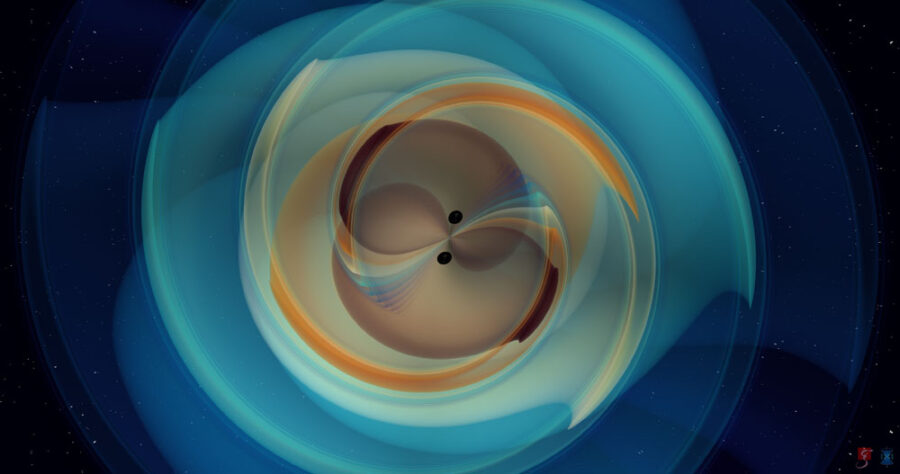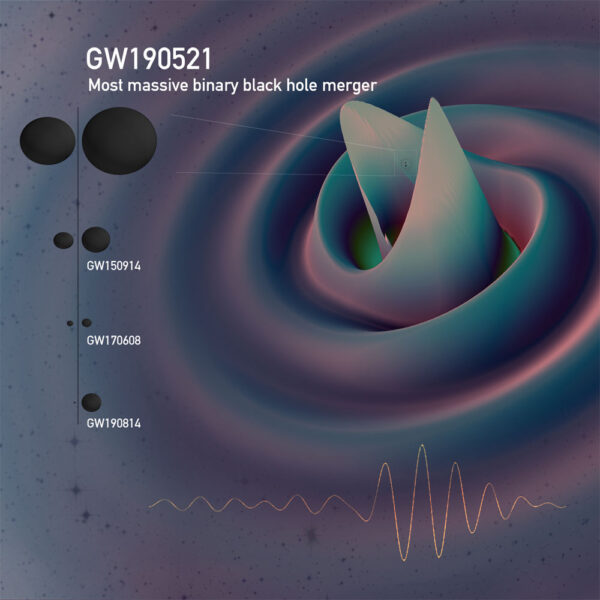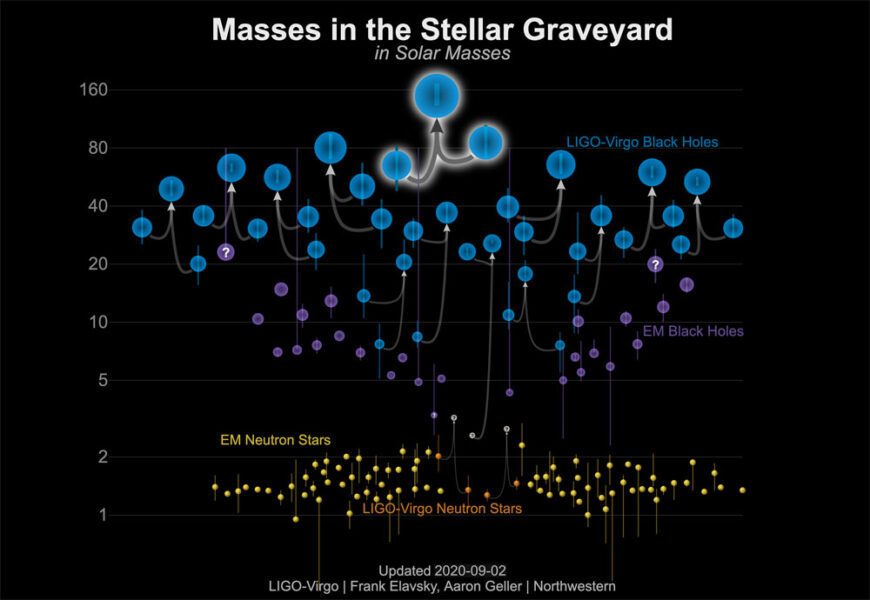Gravitational-wave observatories have detected the most massive black hole merger yet, and it’s challenging our ideas of black hole formation.

N. Fischer / H. Pfeiffer / A. Buonanno (Max Planck Institute for Gravitational Physics) / Simulating eXtreme Spacetimes (SXS) Collaboration
A brief burst of spacetime ripples, registered on May 21, 2019 at 03:02:29 UT by the American LIGO and the European Virgo gravitational-wave detectors, confirms the existence of intermediate-mass black holes. It also provides astrophysicists with new insights on the growth of these cosmic gluttons.
“This is hugely exciting,” says black hole researcher Jenny Greene (Princeton).
GW190521, as the 0.1-second signal has been catalogued, was produced some 7 billion years ago, when two “stellar-mass” black holes in a remote galaxy collided and merged into a 142-solar-mass behemoth – by far the heaviest black hole ever found via gravitational waves. The discovery suggests that black holes can grow through successive mergers, maybe all the way up to the supermassive ones found in the cores of galaxies.
The very short duration and the low frequency (about 60 hertz) of the gravitational-wave signal left some wiggle room for other, even more exotic explanations, but the most likely cause is an extremely massive black hole merger, says Virgo collaboration member Chris Van Den Broeck (University of Utrecht, The Netherlands). A detailed analysis of the signal, published September 2nd in Physical Review Letters, reveals that the two colliding black holes weighed in at unprecedented masses, 66 and 85 times the Sun, respectively.

Deborah Ferguson / Karan Jani / Deirdre Shoemaker / Pablo Laguna / Georgia Tech / MAYA Collaboration
According to astrophysical wisdom, supernova explosions cannot produce black holes with masses between 65 and 120 solar masses. The progenitor stars would have to be between 130 and 200 solar masses or so, but such heavyweights would suffer from a process called pair instability, which blows the star apart without leaving anything behind.
So in the case of GW190521, at least the 85-solar-mass black hole (and possibly the 66-solar-mass one as well) must have formed in a different way — perhaps through an earlier merger event. “Getting an 85-solar-mass black hole is not straightforward, and this could suggest hierarchical merging in a dense environment, like a globular cluster,” says Jay Strader (Michigan State University), an expert on globulars.
The gravitational wave event not only marks the first-ever discovery of a black hole in the so-called pair instability mass gap. The end result of the merger is also the first reliable detection of a black hole with more than 100 solar masses, says Luis Ho (Peking University, China): “These are the long-sought seeds needed to build supermassive black holes.”

LIGO-Virgo / Northwestern U. / Frank Elavsky & Aaron Geller
Intermediate-mass black holes (IMBHs) fill the gap between stellar-mass black holes produced by supernova explosions and the supermassive black holes found in galaxy cores, which can contain the mass of millions or billions of Suns. According to a report published simultaneously in The Astrophysical Journal Letters, GW190521 confirms that IMBHs can form through the merger of two less massive black holes — and that IMBHs might indeed be the missing link in supermassive black hole formation.
However, Strader points out that the hierarchical merging scenario for the formation of supermassive black holes is not without its problems: According to simulations, the merger product is typically ejected from the dense environment where successive mergers could occur. “My guess is that GW190521-like objects are not related to supermassive black hole formation, which probably needs to start with more massive seeds, or with growth primarily from gas accretion rather than mergers,” he says.
Greene, who recently wrote a comprehensive paper on intermediate-mass black holes together with Strader and Ho in Annual Reviews, agrees that all seed formation mechanisms have challenges. “No chance we will be lucky enough that all IMBHs could be formed via one process,” she says. “That said, if we can determine that a series of black hole mergers can work, we have learned something very important.”
Future gravitational wave detectors, such as the proposed Einstein Telescope from Europe and the Cosmic Explorer from the U.S., will be able to observe the merger formation of even more massive black holes between 200 and 1,000 times the mass of the Sun — something that LIGO and Virgo cannot do because of their limited frequency coverage, says Van Den Broeck. Eventually, astronomers may be able to study the birth and evolution of intermediate-mass black holes throughout the history of the universe.
Sky & Telescope contributing editor Govert Schilling is the author of Ripples in Spacetime.
 5
5









Comments
PGT
September 2, 2020 at 4:46 pm
Just in case readers are not aware, LIGO is part of the citizen scientist Zooniverse:
https://www.zooniverse.org/projects/zooniverse/gravity-spy.
You must be logged in to post a comment.
pwrgilson
September 5, 2020 at 8:01 pm
Silly question - if you were too close to an event such as this, say under 5000lyrs, would the gravity waves passing through us have enough energy to distort and break the molecular bonds between our atoms. I imagine the frequency of the gravitational waves is not right - but would be a hell of a way to die!
You must be logged in to post a comment.
pwrgilson
September 5, 2020 at 8:41 pm
And the planet, instantaneously turned into a spherical pile of atoms, most of which are gases.
You must be logged in to post a comment.
Deryk Houston
September 6, 2020 at 10:39 am
I was wondering if they take into acount the magnetic forces running through the cosmic web and filaments when they crunch these numbers. I would suspect that those forces and strands might play a huge part in all this and yet I don;t hear any reference to them in this case. Doesn't it seem likely that if gallexies are formed, for the most part, where these filaments intersect and black holes are found at the center of gallexies that the magnetic forces in those strands could have enormous influence on what we are observing? So why are these forces not talked about or even considered in these equations? Or are they?
You must be logged in to post a comment.
Andrew James
September 18, 2020 at 3:47 am
I was wondering ...
Were is evidence that: "...magnetic forces running through the cosmic web and filaments..."?
Were is evidence that: "...where these filaments intersect and black holes are found at the center"
Were is evidence that: "...that the magnetic forces in those strands could have enormous influence on what we are observing?"
Yet you ask: "So why are these forces not talked about or even considered in these equations? Or are they?"
Black holes aren't any kind of electrically phenomena, the "Big Bang' on actual evidence is likely true, Maxwell's equations are approximations and heavily reliant that the Universe is infinitely large and old. (...and Arp was not framed.) Or are they?.
You must be logged in to post a comment.
You must be logged in to post a comment.